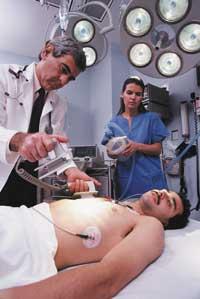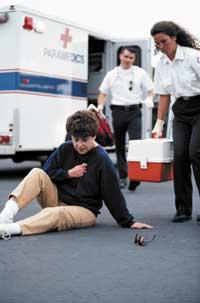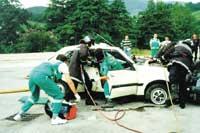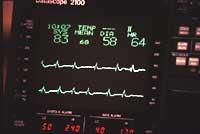Stimulate your heart wherever you are
2004/03/01 Ibarguren Olalde, Karlos | Alonso Moreno, Daniel | Telleria Barrena, Iñaki | Guirado Perez, Imanol | Berasategi, Ttiko Iturria: Elhuyar aldizkaria

Previously animal tests were performed, but in humans Dr. Beck first used defibrillation. He entered the Cleveland hospital in 1947. The patient was in the operating room. His chest was open and the doctor placed the blades emitting the discharge directly on his heart.
However, on the thoracic skin was not done until 1956. This technique still had an important limit: the doctor had to diagnose arrhythmia and decide whether the discharge was correct or not.
Things start to change in 1970. The device itself developed a computer program that automatically identified arrhythmias and in 1979 the first out-of-hospital defibrillation was performed with a semi-automatic external defibrillator. This currently allows out-of-hospital defibrillation in two types of ambulances: on the one hand, those of advanced life assistance, which lead to a doctor and a nurse, so they can use the conventional defibrillator, and on the other, those of basic life support. These do not carry doctors, but now they can use a semi-automatic external defibrillator.
Semi-automatic defibrillators have many advantages. They are easy to use, highly accurate and can be stored anywhere. When arrhythmia is detected, in the fight against death, every minute is very important. In just 10 minutes without blood, the brain can suffer excessive damage that can cause death. Therefore, it is essential that Basic Vital Care ambulances have semi-automatic defibrillators. And is that if the defibrillation is by doctor, being few ambulances of this type, often do not arrive in time. It is also useless for the unconscious patient to move to the hospital, which means excessive waste of time and inadequate resuscitation on the way to the hospital. It often takes more than 20 minutes to get there.

The use of the semi-automatic defibrillator is widespread in the Basque Country. In Iparralde they were the first to regulate their use in May 1998. It was then determined who can use it and what training it needs before using it. According to this, the course must be taught by a doctor and if the exam is passed a one-year certificate is obtained. This is the case with firefighters.
In Navarra, the use of defibrillators was subsequently regulated in 2002. And while CAPV is used by Basic Vital Care ambulances, the use of defibrillators is not yet regulated.
Also outside the ambulance
But the future goal is that, without the need for ambulances, the defibrillator can be used anywhere. In some municipalities other non-health users such as security service personnel have been trained. The reason is simple: the more users they have, the greater the possibility of preventing the death of the patient.
In the United States, for example, you can buy it online or in pharmacies, always under the orders of doctors. The price includes a training course, as various resuscitation organizations around the world consider that training can be achieved with a course of about eight hours.

Although the place where the appliance should be placed is not yet established, it will henceforth be required by law in many places. The objective is to install it in places of great influx of public as airports, companies, beaches, shops and sports. And in hard-to-reach places like planes, trains, boats, ski resorts or agricultural areas. Semi-automatic defibrillators have already been installed in several countries in these places.
What is the next step?
Many people have also taken one step further: it has introduced an automatic defibrillator inside. It is small and placed like a pacemaker. It constantly analyzes the rhythm of the heart and, in case of detecting arrhythmias, gives the scheduled treatment, including electric shock.
This device applies to high-risk patients, but since we can't predict who will be sudden death, aren't we all included in the risk group? Recent studies have tried to delimit the risk group, and it seems that we could be on track to achieve it through blood tests.
Arrhythmic or rhythmic, the goal is to contract the heart, because when contracted, the heart pumps the blood from the cavities throughout the body. However, it cannot be said that all arrhythmia alters good blood circulation. We all know someone arrhythmia, the older person, normally. The heart has weakened over the years and shrinks gradually. But with arrhythmia he lives peacefully. However, there are other dangerous arrhythmias that cut traffic. Sudden changes occur in the heart rate, leaving the body's cells without nutrients or oxygen, which are vulnerable. This is when the brain runs out of food. Some of these arrhythmias are ventricular fibrillation and pulse free ventricular tachycardia. The electrical activity of the heart is too fast and the heart is not able to maintain circulation. But despite being dangerous diseases, there is a solution, since both are defibrillating diseases. That is, by electric discharge in time with the defibrillator you can get the heart to recover the right rhythm. It is about stopping at first all the electrical activity of the heart by discharging, hoping that another more suitable rhythm will correct the activity of the heart and restore circulation. In fact, it is a sinus node that usually sets rhythm to the heart and, after discharge, takes the direction of electrical activity again. |
Too often, the person who has no history abruptly loses knowledge and falls to the ground, despite not having suffered pain. Abrupt changes in the rhythm of the heart cause the brain not to get enough oxygen and glucose. After noisy breaths stop breathing. The race against time begins, the fight against death. It is necessary to give the electric shock as soon as possible so that the heart comes out of the pause and takes the usual rhythm.

To start, call 112. But it is also easy for us to use a semi-automatic external defibrillator. In the patient's chest, just place the patches correctly and turn on the device. The device will begin to study for itself the patient's heart rate and at all times will tell us verbally what he is doing. Once the analysis is completed, it will tell us whether or not to give it. That is, if the arrhythmia is defibrillable, if it is an arrhythmia with discharge that the heart recovers the normal rhythm.
If it is necessary to discharge, press the button and the defibrillator itself will release the necessary energy. It has a special high-voltage energy storage system. But the duration of the discharge varies from person to person. In fact, the skin and muscles of the human body resist the current and first measure the resistance that the apparatus brings to the current.
Until the patient is formed, the defibrillator monitors the heart rate and keeps in memory all the measurements and discharges carried out, as well as the indications of the resuscitators. Thus, upon arrival at the hospital, the doctor will be able to review all the data on the computer to know the patient's response to the download and centralize treatments and perform statistics.

Gai honi buruzko eduki gehiago
Elhuyarrek garatutako teknologia





